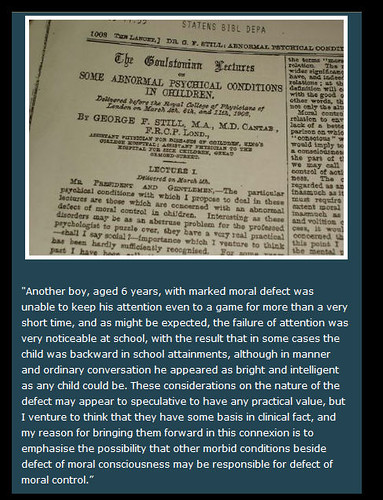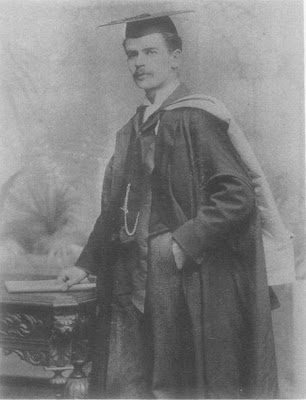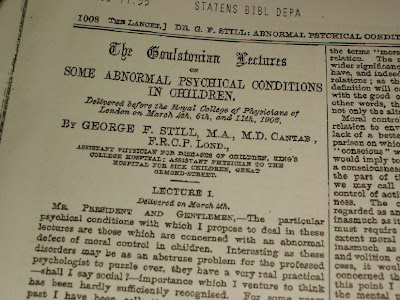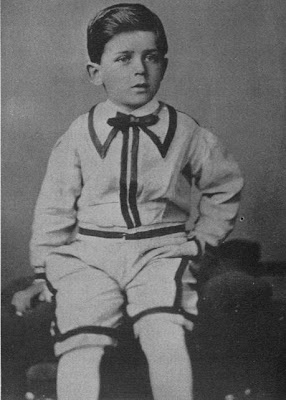Här hamnade slutresultatet
Ja till slut så bidde det en egen sida av historiken…
ADHD History
The History of ADHD: 1798, Alexander Crichton
The absolutely first known history of ADHD was written already in 1798 by a Scottish-born physician and author, Sir Alexander Crichton (1763-1856).
He described what seems to be a similar mental state much like the inattentive subtype of ADHD, in his book: An inquiry into the nature and origin of mental derangement: comprehending a concise system of the physiology and pathology of the human mind and a history of the passions and their efects. In the chapter ”Attention”, Crichton described a ”mental restlessness”.
The history of ADHD 1902, Sir George Frederick Still
Sir George Frederick Still (1868-1941) The father of British pediatrics.
England’s first professor in child medicine presented on 4th, 6th and 11th March 1902 a series of three lectures to the Royal College of Physicians in London, under the name “Goulstonian lectures” on ‘some abnormal psychical conditions in children’, which were published later the same year in the Lancet. He described 43 children who had serious problems with sustained attention and self-regulation, who were often aggressive, defiant, resistant to discipline, excessively emotional or passionate, who showed little inhibitory volition, had serious problems with sustained attention.
The history of British Pediatrics: Sir George Frederick Still
Sir George Frederick Still (1868-1941) The father of British pediatrics.
Sir George Frederick Still (1868-1941) the father of British pediatrics. He was born in Highbury, England, and attended medical school at Cambridge University. His father died when he was 17 years of age, causing a dramatic change in the family economy.
Swedish
ADHD Historia 1798: Alexander Crichton
Den första väldokumenteradebeskrivningen av ADHD liknande fenomenologi
Alexander Crichton del 2
Alexander Crichton berörde i sin bok, svårigheten för personerna med den ‘mentala rastlös heten’ att filtera bort intryck och hur överkänsliga personerna var för olika händelser som inte verkade påverka andra i alls samma omfattning.
Englands förste professor i barnmedicin presenterade den 4, 6 och 11 Mars 1902 sina sedermera berömda föreläsningar för the Royal College of Physicians in London, under namnet “Goulstonian lectures” som handlade om ‘some abnormal psychical conditions in children’, Föreläsningarna publicerades samma år i the Lancet. Han beskrev 43 barn som hade mycket allvarliga problem med att upprätthålla en kontinuerlig uppmärksamhet, att disciplinera sig själva och att inte bli ständigt överemotionella, aggressiva eller passionerat upptagna med något för situationen olämpligt.
1937 Benzedrine – den första ADHD medicinen
Det stora sensationella medicinska genombrottet för personer med svårigheter att sitta stilla och koncentrera sig, kom en bit in på 30-talet i form av den centralstimulerande medicineringen, Benzedrine, som tvärtemot vad man kunde tro lugnade ner barnen och gjorde dem mindre stökiga, ja rent av lugna, samt gav dem bättre förutsättningar till att upprätthålla sin koncentrationsförmåga under länge tid, som andra barn.
Sir George Frederick Still (1868-1941)
Englands förste professor i barnmedicin presenterade den 4, 6 och 11 Mars 1902 sina sedermera berömda föreläsningar för the Royal College of Physicians in London, under namnet “Goulstonian lectures” som handlade om ‘some abnormal psychical conditions in children’, Föreläsningarna publicerades samma år i the Lancet. Han beskrev 43 barn som hade mycket allvarliga problem med att upprätthålla en kontinuerlig uppmärksamhet, att disciplinera sig själva och att inte bli ständigt överemotionella, aggressiva eller passionerat upptagna med något för situationen olämpligt.
ADD era Alexander, Crichton, 1798, Georgestill, 1902, Goulstonian lectures, ADHD historia,
Är det den perfekta historiksidan för ADHD och ADD eller finns det förbättringar att göra? Flickr ADHD History.










